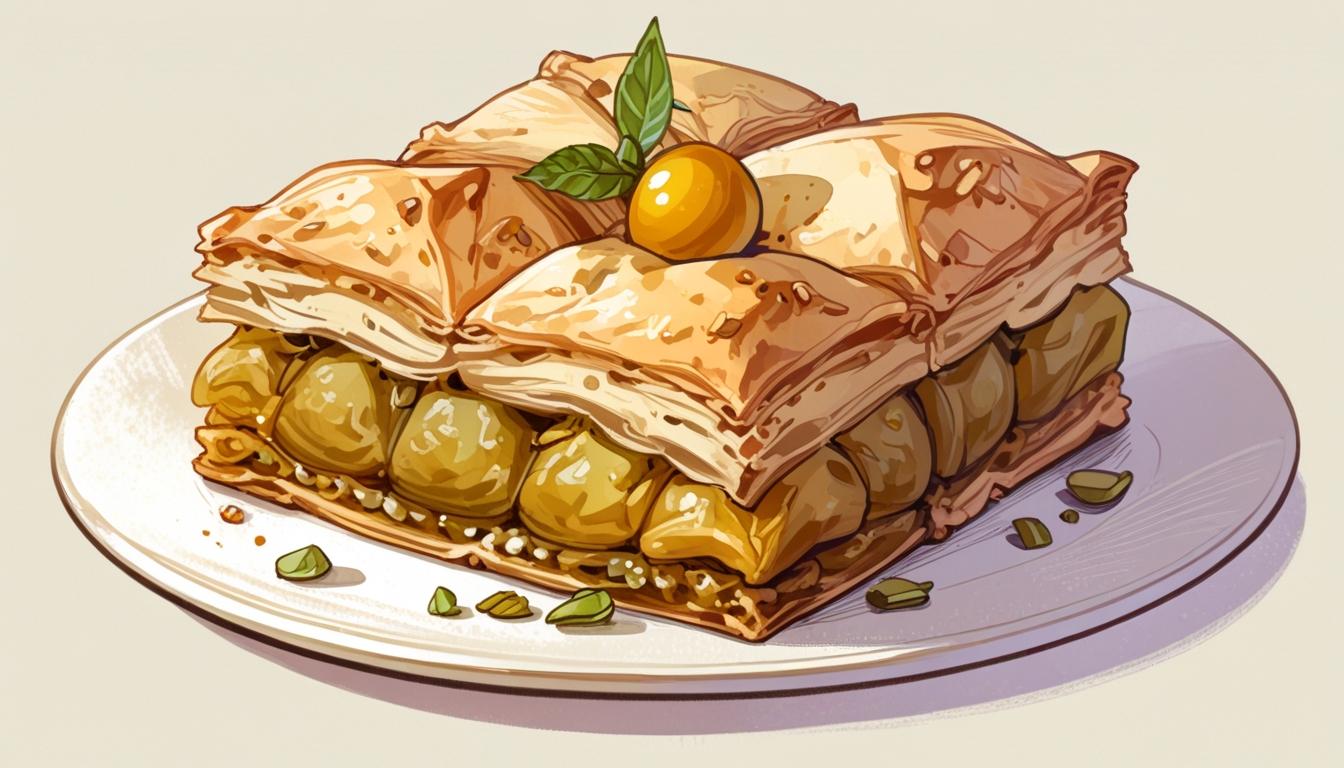A surprising incident where two award-shortlisted chefs independently created the same baklava recipe has reignited discussions about originality, inspiration, and plagiarism within the food industry, highlighting challenges in distinguishing creativity from imitation in a tradition-rich culinary world.
This week, a delightful yet contentious episode unfolded within Australia’s culinary sphere as two chefs, both shortlisted for a prestigious cookbook award, declared they had independently created identical baklava recipes. This incident, while seemingly trivial, raises deeper questions about originality and the nature of creativity in a world overflowing with culinary ideas.
The debate surrounding these baklava recipes illuminates a significant aspect of cooking: the fine line between inspiration and outright imitation. In a vast landscape of culinary traditions, it’s a challenge to conceive a truly unique recipe. The writer reflects on the myriad ways one can combine basic ingredients — milk, sugar, eggs — observing that most cookbooks tend to recycle ideas and techniques. Indeed, this phenomenon is not new; seasoned cooks often note parallels and similarities in recipes that can lead to unintended similarities across different works.
This serves to highlight a broader issue that has long plagued the food industry. Numerous instances of recipe plagiarism have surfaced, revealing that many authors grapple with originality. A notable example is the controversy surrounding the cookbook “Makan: Recipes from the Heart of Singapore,” where author Elizabeth Haigh was accused of borrowing heavily from Sharon Wee’s family memoir. Following these allegations, the book was withdrawn, raising alarms about the need for proper attribution and the legacy of culinary heritage.
Furthermore, the rampant nature of recipe copying has garnered significant attention. In a saturated market, it is all too easy for well-intentioned recipes to blur into each other, leading to accusations of theft rather than tribute. As seen in numerous cases reported across the culinary landscape, the problem is not merely one of morality; it encompasses legal ramifications concerning copyright in the culinary arts. The conditions surrounding recipe creation are intricate, as food is inherently communal, with recipes often evolving through generations of shared tastes and influences.
The writer poignantly reminds readers of the modern challenges posed by technological advancements, including the rise of artificial intelligence in culinary recipe generation. There is a palpable need for food writers and cooks to cultivate genuine connections with their audience, ultimately offering unique insights that only a human perspective can provide. This sentiment resonates particularly in an age where information is readily accessible and easily duplicated.
As the baklava dispute unfolds, it is essential to appreciate the culinary continuum to which these chefs contribute. The ancient origins of baklava — a dessert that has transcended centuries — remind us that creativity often springs from a rich tapestry of tradition and shared experiences. As we engage in this discourse about originality, it becomes clear that acknowledging our culinary ancestors is not just respectful but an acknowledgment of the sweetness that binds us together through food. This understanding fosters an environment where inspiration thrives, rather than one stifled by accusations of plagiarism.
In the end, rather than seeing each other merely as competitors, chefs should also view their recipes as part of a kaleidoscope of culinary creativity, where every dish inherits something from those who came before. After all, the essence of cooking lies not only in the recipes themselves but in the stories, techniques, and influences that shape our understanding of food and culture.
Reference Map
- Paragraphs 1-2: Source 1, Source 2
- Paragraphs 3-4: Source 3, Source 4
- Paragraph 5: Source 5, Source 6
- Paragraph 6: Source 2
- Paragraph 7: Source 1, Source 4
- Paragraph 8: Source 6, Source 7
Source: Noah Wire Services
- https://www.ft.com/content/8fc43dcb-c61c-4099-99ce-d01fee409d57 – Please view link – unable to able to access data
- https://www.ft.com/content/8fc43dcb-c61c-4099-99ce-d01fee409d57 – An article discussing a controversy in Australia’s culinary scene where two chefs, both shortlisted for a prestigious cookbook prize, claim to have independently created the same baklava recipe. The piece explores the challenges of originality in recipe creation, noting that many recipes inevitably draw from others due to the limited ways ingredients can be combined. It reflects on the blurred line between inspiration and plagiarism in culinary arts, emphasizing the importance of attributing ideas and celebrating shared culinary heritage.
- https://www.washingtonpost.com/food/2021/10/11/makan-cookbook-singapore-plagiarism/ – An article reporting on the withdrawal of the cookbook ‘Makan: Recipes from the Heart of Singapore’ by Elizabeth Haigh amid plagiarism allegations. The author was accused of copying or paraphrasing recipes and passages from Sharon Wee’s 2012 family memoir, ‘Growing Up in a Nonya Kitchen.’ The publisher, Bloomsbury, withdrew the book from circulation due to rights issues, highlighting the importance of originality and proper attribution in the culinary world.
- https://www.eater.com/2015/3/19/8259393/recipe-plagiarism-in-the-food-world-is-still-rampant – An article discussing the prevalence of recipe plagiarism in the culinary industry. It highlights instances where cookbook authors and chefs have found their recipes copied without credit, emphasizing the challenges of maintaining originality in a saturated market. The piece underscores the importance of proper attribution and the ethical considerations involved in recipe creation and sharing.
- https://www.plagiarismtoday.com/2015/03/24/recipes-copyright-and-plagiarism/ – An article examining the complexities of copyright and plagiarism in the culinary world. It discusses notable cases, such as the controversy involving Food Network star Anne Thorton, who was accused of lifting recipes from other chefs with minimal modifications. The piece explores the challenges of defining originality in recipes and the legal and ethical implications of recipe plagiarism.
- https://www.euronews.com/culture/2022/01/31/how-can-you-copyright-scrambled-eggs-battling-plagiarism-in-the-food-industry – An article exploring the challenges of defining originality and plagiarism in the culinary industry. It discusses instances where chefs have found their recipes copied without credit and the difficulties in protecting culinary creations under copyright law. The piece highlights the blurred lines between inspiration and copying in the food world and the ongoing debates surrounding recipe plagiarism.
- https://en.wikipedia.org/wiki/Mrs._Beeton%27s_Book_of_Household_Management – A Wikipedia article detailing the history and content of ‘Mrs. Beeton’s Book of Household Management,’ a seminal 19th-century cookbook. The article discusses the book’s influence on domestic cooking and its controversial aspects, including allegations of plagiarism. It provides insights into the practices of cookbook authors in the 19th century and the challenges of originality in recipe creation.
Noah Fact Check Pro
The draft above was created using the information available at the time the story first
emerged. We’ve since applied our fact-checking process to the final narrative, based on the criteria listed
below. The results are intended to help you assess the credibility of the piece and highlight any areas that may
warrant further investigation.
Freshness check
Score:
9
Notes:
The narrative describes a current incident involving chefs in Australia and references recent examples such as the ‘Makan’ cookbook controversy, which is relatively recent. There are no indications of outdated information or recycled news, and the discussion on AI in culinary arts suggests topicality.
Quotes check
Score:
8
Notes:
The content contains indirect references and general reflections rather than direct quotes. The mention of the ‘Makan’ controversy is verifiable and well-documented elsewhere, but no precise dated quotes are provided or verifiable. This suggests originality in commentary rather than repeating quoted material.
Source reliability
Score:
9
Notes:
The narrative originates from the Financial Times, a globally recognised and reputable publication known for thorough editorial standards and factual accuracy, which supports high reliability.
Plausability check
Score:
9
Notes:
The claims regarding recipe similarity, plagiarism issues in cookbooks, and challenges with originality in cooking are plausible and consistent with known industry issues. The influence of AI on recipe creation is a recent and credible trend. The story cannot be independently verified in every detail but aligns well with contemporary culinary debates.
Overall assessment
Verdict (FAIL, OPEN, PASS): PASS
Confidence (LOW, MEDIUM, HIGH): HIGH
Summary:
The narrative is recent and topical, originating from a highly reputable publication. It mainly consists of reflective analysis on originality in cooking rather than unverifiable claims or quotations. The contextual references to recent controversies and AI in culinary arts underpin its plausibility and freshness, justifying a high confidence in its overall accuracy.













